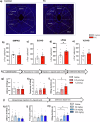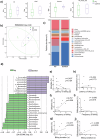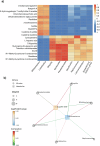Effect and mechanism of father's companionship on defensive attack behavior of adult male offspring mice
- PMID: 40715619
- PMCID: PMC12297315
- DOI: 10.1038/s42003-025-08531-9
Effect and mechanism of father's companionship on defensive attack behavior of adult male offspring mice
Abstract
Sociocultural changes in recent decades have promoted fathers' involvement in childcare, which is crucial for the brain and behavioral plasticity of offspring. The study elucidates the effect and mechanism of father's companionship on defensive attack behavior of adult male offspring mice. The study comprises a father companionship group, where offspring cohabited with sire and dam until weaning, and a control group, where offspring cohabited solely with the dam until weaning. The study shows that father's companionship increases defensive attack behavior of adult offspring. Additionally, the metabolite L-aspartic acid is upregulated in the father's companionship group compared to the control group in male offspring, and intracerebroventricular micro-injection of L-aspartic acid confirms its impact on defensive attack behavior. C-Fos immunohistochemistry reveals that c-Fos expression in lateral periaqueductal gray (LPAG) is activated. Subsequently, micro-injection of L-aspartic acid into LPAG increases defensive attack behavior. Additionally, 16S rRNA sequencing reveals a higher abundance of Bilophila and a lower abundance of Bifidobacterium in the father companionship group, which correlates with L-aspartic acid levels, suggesting a gut-brain axis mechanism for the effect of father companionship on defensive attack behavior.
© 2025. The Author(s).
Conflict of interest statement
Competing interests: The authors declare no competing interests.
Figures






Similar articles
-
Study on the Correlation Between Aggressive Behavior and Gut Microbiota and Serum Serotonin (5-HT) in Working Dogs.Vet Sci. 2025 May 28;12(6):526. doi: 10.3390/vetsci12060526. Vet Sci. 2025. PMID: 40559763 Free PMC article.
-
A systematic review of qualitative evidence: Perspectives of fathers whose partner experienced postpartum psychosis.J Adv Nurs. 2024 Feb;80(2):413-429. doi: 10.1111/jan.15832. Epub 2023 Sep 1. J Adv Nurs. 2024. PMID: 37658618
-
Interventions with fathers of young children: systematic literature review.J Adv Nurs. 2006 Jul;55(2):248-64. doi: 10.1111/j.1365-2648.2006.03896.x. J Adv Nurs. 2006. PMID: 16866816
-
A hypothalamus-lateral periaqueductal gray GABAergic neural projection facilitates arousal following sevoflurane anesthesia in mice.CNS Neurosci Ther. 2024 Sep;30(9):e70047. doi: 10.1111/cns.70047. CNS Neurosci Ther. 2024. PMID: 39317457 Free PMC article.
-
The impact of early-life exposures on growth and adult gut microbiome composition is dependent on genetic strain and parent- of- origin.Microbiome. 2025 Jun 16;13(1):143. doi: 10.1186/s40168-025-02130-w. Microbiome. 2025. PMID: 40524209 Free PMC article.
References
-
- Sly, P., Blake, T. & Islam, Z. Impact of prenatal and early life environmental exposures on normal human development. Paediatr. Respir. Rev.40, 10–14 (2021). - PubMed
-
- StGeorge, J. M., Wroe, J. K. & Cashin, M. E. The concept and measurement of fathers’ stimulating play: a review. Attach Hum. Dev.20, 634–658 (2018). - PubMed
-
- Savage, L. -É, Tarabulsy, G. M., Pearson, J., Collin-Vézina, D. & Gagné, L.-M. Maternal history of childhood maltreatment and later parenting behavior: A meta-analysis. Dev. Psychopathol.31, 9–21 (2019). - PubMed
MeSH terms
Substances
LinkOut - more resources
Full Text Sources

